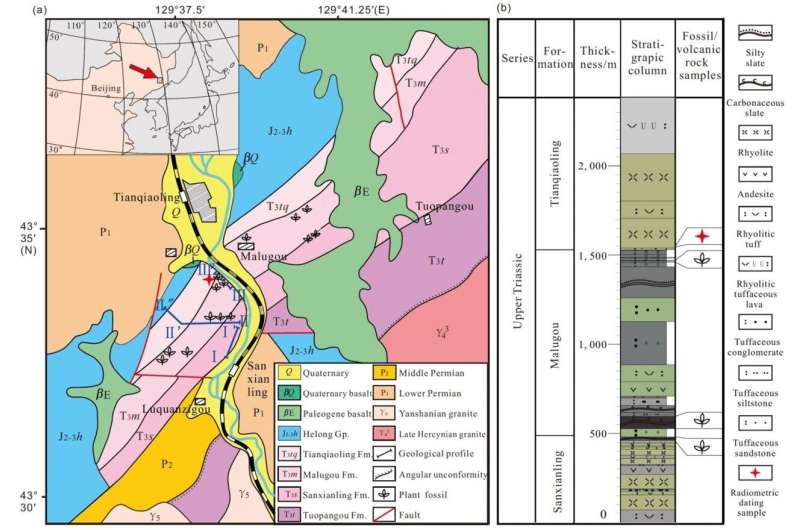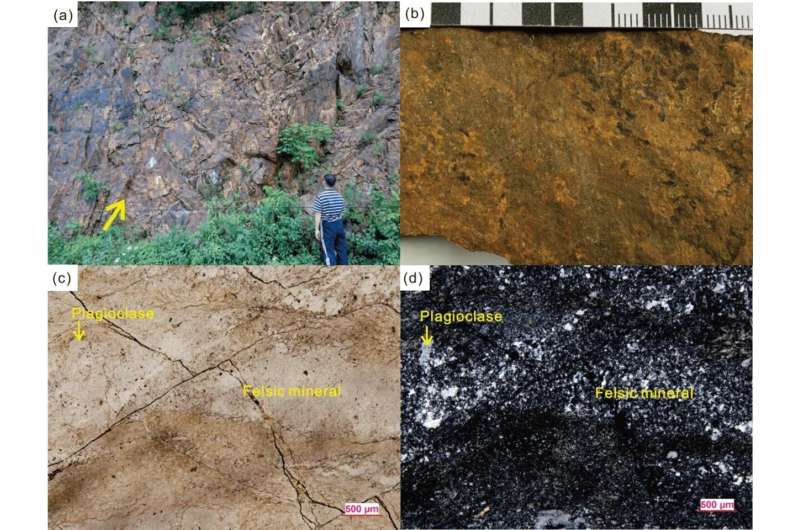New U-Pb zircon ages document Late Triassic Tianqiaoling flora of eastern Jinlin, NE China

The Late Triassic Tianqiaoling flora is well-known in China, and its discovery has changed our understanding of Chinese Late Triassic phytogeographical divisions. More broadly, this flora has great significance for the study of phytogeography in East Asia during this time. However, the previous dating of this flora was only evidenced by plant fossils and stratigraphic correlation, and the accurate dating has still not been achieved.
Recently, the team of Dr. Yuhui Feng of Shenyang Normal University collected isotope dating samples from the bottom of the Tianqiaoling Formation, which is conformally contacted the Tianqiaoling flora-bearing beds. The results of new U-Pb dating gave ages for the rhyolites of 212.8±2.5 Ma, indicating the end of Malugou Formation and initial Tianqiaoling Formation in deposition occurred in the late Norian (~227-208.5 Ma), which is contemporaneous with the peak of the Tianqiaoling flora in development.
The Tianqiaoling of Wangqing, eastern Jilin, NE China, has extensive non-marine Upper Triassic strata yielding the well-known Late Triassic Tianqiaoling flora. The discovery of this flora is interested and very significant for the Late Triassic phytogeography in East Asia. Since the Tianqiaoling flora has the floristic characteristics of "Southern type flora" (Dictyophyllum-Clathropteris flora) in China and is found in the Northeast China, it has changed our understanding of the Late Triassic phytogeographical divisions in China, and provided new data for floral comparison and stratigraphic correlation of flora-bearing beds in the eastern Jilin of China, South Primorye of Russia and Southwest Japan.
However, the previous dating of the Tianqiaoling flora was based only on the evidences of the fossil plants and stratigraphic correlation of the Tianqiaoling with those of the South Primorye (Russia) and southwestern Japan dated by marine beds, while the accurate dating of this flora has still not been achieved. The Tianqiaoling flora and its strata are lack of isotopic dating, which has been puzzled and regretted for the paleobotanists concerned.

Recently, on the basis of detailed field geological profile analysis in the flora-bearing stratotype, members of the Evolution of Past Life in Northeast Asia research team from the college of Paleontology, Shenyang Normal University obtained the dating sample of the rhyolite from the bottom of the Tianqiaoling Formation, conformable with Tianqiaoling flora-bearing beds, which has been the best attempt to date the Tianqiaoling flora, so far.
This present dating sample was analyzed by laser ablation-inductively coupled plasma-mass spectrometry (LA-ICP-MS) of zircon U-Pb, and produced an age of 212.8±2.5 Ma. The present new U-Pb age (212.8±2.5 Ma) for the bottom of the Tianqiaoling Formation suggests that the end deposition of the Malugou Formation and initial deposition of the Tianqiaoling Formation occurred in the later Norian, contemporaneous with the peak interval for the Tianqiaoling flora in development.
The new radiometric dating is not only basically consistent with those of paleobotanical data, but also provides a key anchor point for regional stratigraphic correlation between the Tianqiaoling flora and other Late Triassic floras, such as Nariwa and Yamaguchi floras and Amba flora. Thereby, this study contributes to a better understanding of the geology and phytogeography in the East Asian region covering the "triangle region" including the eastern Jilin of China, South Primorye of Russia and SW Japan during the Late Triassic.
More information: Yuhui Feng et al, New U-Pb zircon ages document Late Triassic Tianqiaoling flora of eastern Jinlin, NE China, Science China Earth Sciences (2021). DOI: 10.1007/s11430-020-9707-4
Journal information: Science China Earth Sciences
Provided by Science China Press




















